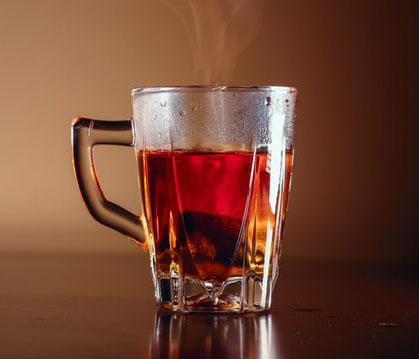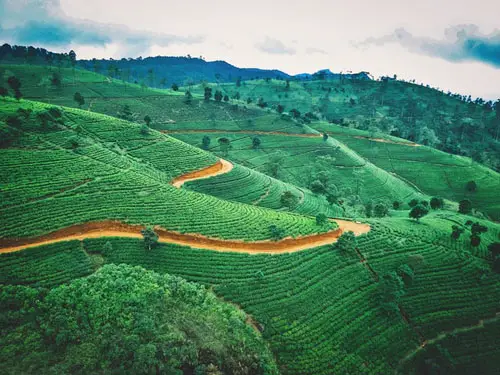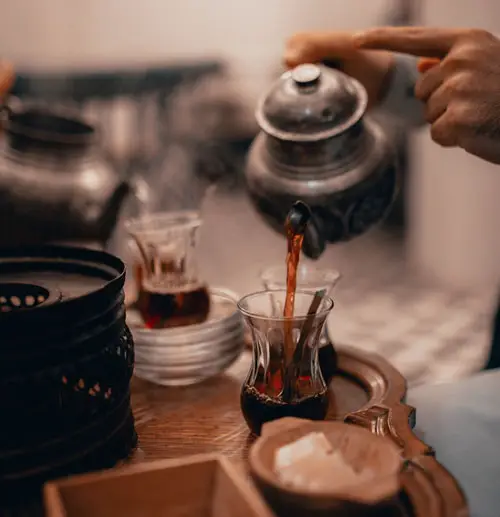
Nilgiri is truly a one of a kind brew.
This is one of the teas that my family and I used to add to our masala chai so it does have a special place in my heart. Here is a breakdown of what this tea is and what you should know about it:
Contents
Although its name may not reveal as such, Nilgiri tea is actually a black tea. Nilgiri tea refers to the teas grown in plantations in the Nilgiri mountains in South India. The mountains themselves are located in a part of the Western Ghats, in an area that is now recognized as Tamil Nadu. In earlier times, the area also belonged to Kerala and Karnataka.
These days, you do find other types of tea being grown in the Nilgiri hills. However, when most people refer to Nilgiri tea, they are referring to the intensely aromatic teas that are grown in this region of South India.

These days, the tea from the Nilgiri district is a major player in the tea industry. This is why it is quite interesting to learn that tea was introduced to the Nilgiri region by the British much later on, in the nineteenth century.
Although the teas grown in this area is delicious, its high elevation does create some production issues. Thus, it took the experts a while to discover how to grow tea in these plantations in a cost-effective manner. Now, however, the vast majority of teas in India comes from this Southern India region.
One of the reasons that teas that are planted here prosper is due to the specific climate of the Blue Mountains. The low latitude of the region gives way to warm and moist weather conditions. In fact, this region experiences two monsoons, which allows the plants to bud all year round.
There is one kind of tea known as frost tea that is harvested during the cold weather months. It is quite rare and offers up an unusual and fascinating flavor.

Before investing in Nilgiri teas, it is important to realize that like with most black teas, there are several categories of quality. While growing conditions of the region play a part in the quality, it is actually the tea production that will ultimately determine the kind of brew that you end up in.
Once the tea leaves and buds are plucked from the tea bushes, they will undergo processing in the factories. The higher level leaves are sun dried and carefully handled so that they remain largely whole. When brewed, these leaves will produce a yellow drink.
Leaves that are slightly broken still produce good quality teas. However, the drink will be a little darker in color and the flavour will be a lot stronger as well.
Finally, there is the CTC tea. In the earlier days, most of the tea grown in this South India region was premium teas. After a while, though, tea estates were encouraged to produced the cheaper CTC version. The beverage is a lot darker and may have a bit more astringency to it. These may be found in dust teas or affordable tea bags.
If you do want to enjoy a balanced and sweet cup, it is a good idea to look for small growers instead of Nilgiri teas produced by larger companies. The independent growers in Southern India take greater care with the process and can also ensure that your tea comes from a single estate.
One of the reasons that Nilgiri tea is quite so popular is due to its flavour. Most black tea from Assam and Ceylon tend to have at least a hint of astringency. This isn't the case with Nilgiri tea, though. This tea is incredibly well balanced.
While it doesn't hold the same kind of sway as Darjeeling tea, it does have floral and fruity notes to it. Sometimes, there may be a hint of woodiness to it as well.
Now, the higher quality Nilgiri teas do have a more mellow, smooth taste that progresses into stronger notes as you go down in quality. Premium Nilgiri teas should be enjoyed without any other additions. The stronger brews may act as bases for other teas or ingredients.

Nilgiri tea offers many of the same health advantages as other kinds of black tea. One of the main benefits of Nilgiri black tea is that it contains an abundance of antioxidants such as polyphenols that can help to prevent cell damage from free radicals. In turn, it works wonders for preventing a number of medical conditions such as diabetes.
Flavonoids in the tea can also help to prevent heart disease and other related issues. There is even some evidence that it can help to prevent certain types of cancer. Thus, enjoying this drink on a regular basis can do you a great deal of good in the long run.
Use 8 ounces of water for every person. Pour filtered water into a kettle and heat water just until boiling. Take the kettle off the heat.
Use one tea bag or one teaspoon of tea leaves for every cup. You can add more if you prefer a stronger brew. Add the tea to the cup and pour in the water. Let it steep for three to five minutes, depending on your preferred strength.
It is a good idea to test the taste after the three minute mark to know when the tea has steeped enough. Remove the bag or strain the tea out.
Due to the fresh and delightful taste of this tea, it is quite common to make iced tea out of it. However, for the best results, consider making a cold brew form of iced tea. This will produce a far better flavour.
For each person, use one teaspoon of tea but halve the quantity of water - you can top it up once the tea has finished brewing. Add the tea and the water to a glass container, close tight, and refrigerate for up to 8 hours. When serving, add more iced water or iced cubes to dilute the iced tea.

As mentioned, the premium tea leaves require no additions. However, you may want to milk and sugar to the tea dust or cheaper versions. You can also add spices to create a perfect cup of masala chai.
This is what you need to know about the delicious and fascinating Nilgiri tea. Now, you can give it a try knowing exactly what it is.
If you enjoyed this post, make sure to check out our Pinterest page. We have tons of other content for you there.
